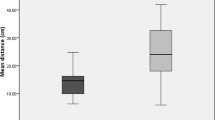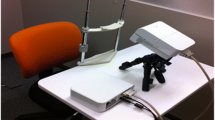Abstract
Sensory issues have been widely reported in Autism Spectrum Conditions (ASC). Since olfaction is one of the least investigated senses in ASC, the current studies explore olfactory detection thresholds and adaptation to olfactory stimuli in adults with ASC. 80 participants took part, 38 (18 females, 20 males) with ASC and 42 control participants (20 males, 22 females). A subgroup of participants (N = 19 in each group) also conducted an adaptation task. Standardized “Sniffin’ Sticks” were used to measure olfactory detection levels and adaptation. Adults with and without ASC showed similar olfactory detection thresholds, and similar adaptation to an olfactory stimulus. Since diminished adaptation in ASC has been previously suggested, future research needs to examine adaptation in other modalities as well.


Similar content being viewed by others
References
APA. (1994). DSM-IV diagnostic and statistical manual of mental disorders (4th ed.). Washington, DC: American Psychiatric Association.
Auyeung, B., Baron-Cohen, S., Wheelwright, S., & Allison, C. (2008). The autism spectrum quotient: Children’s version (AQ-Child). Journal of Autism and Developmental Disorders, 38, 1230–1240.
Baron-Cohen, S., Hoekstra, R. A., Knickmeyer, R., & Wheelwright, S. (2006). The autism-spectrum quotient (AQ)-adolescent version. Journal of Autism and Developmental Disorders, 36, 343–350.
Baron-Cohen, S., Wheelwright, S., Skinner, R., Martin, J., & Clubley, E. (2001). The autism spectrum quotient (AQ): Evidence from Asperger syndrome/high functioning autism, males and females, scientists and mathematicians. Journal of Autism and Developmental Disorders, 31, 5–17.
Bennetto, L., Kuschner, E. S., & Hyman, S. L. (2007). Olfaction and taste processing in autism. Biological Psychiatry, 62, 1015–1021.
Brown, C., Tollefson, N., Dunn, W., Cromwell, R., & Filion, D. (2001). The adult sensory profile: Measuring patterns of sensory processing. American Journal of Occupational Therapy, 55, 75–82.
Chamak, B., Bonniau, B., Jaunay, E., & Cohen, D. (2008). What can we learn about autism from autistic persons? Psychotherapy and Psychosomatics, 77, 271–279.
Colbert, H. A., & Bargmann, C. I. (1995). Odorant-specific adaptation pathways generate olfactory plasticity in C. elegans. Neuron, 14, 803–812.
Crane, L., Goddard, L., & Pring, L. (2009). Sensory processing in adults with autism spectrum disorders. Autism, 13, 215–228.
Dalton, P. (1996). Odor perception and beliefs about risk. Chemical Senses, 21, 447–458.
Dalton, P. (2000). Psychophysical and behavioral characteristics of olfactory adaptation. Chemical Senses, 25, 487–492.
Grandin, T. (1996). My experiences with visual thinking, sensory problems and communication difficulties. The Center for the Study of Autism.
Heaton, P., Williams, K., Cummins, O., & Happe, F. (2008). Autism and pitch processing splinter skills: A group and subgroup analysis. Autism, 12, 203–219.
Hrdlicka, M., Vodicka, J., Havlovicova, M., Urbanek, T., Blatny, M., & Dudova, I. (2011). Brief report: Significant differences in perceived odor pleasantness found in children with ASD. Journal of Autism and Developmental Disorders, 41, 524–527.
Hummel, T., Kobal, G., Gudziol, H., & Mackay-Sim, A. (2007). Normative data for the “Sniffin’ Sticks” including tests of odor identification, odor discrimination, and olfactory thresholds: an upgrade based on a group of more than 3, 000 subjects. European Archives of Oto-Rhino-Laryngology, 264, 237–243.
Kern, J. K., et al. (2006). The pattern of sensory processing abnormalities in autism. Autism, 10, 480–494.
Kientz, M. A., & Dunn, W. (1997). A comparison of the performance of children with and without autism on the Sensory Profile. American Journal of Occupational Therapy, 51, 530–537.
Lane, A. E., Young, R. L., Baker, A. E., & Angley, M. T. (2010). Sensory processing subtypes in autism: association with adaptive behavior. Journal of Autism and Developmental Disorders, 40, 112–122.
Leekam, S. R., Nieto, C., Libby, S. J., Wing, L., & Gould, J. (2007). Describing the sensory abnormalities of children and adults with autism. Journal of Autism and Developmental Disorders, 37, 894–910.
Pellicano, E., Jeffery, L., Burr, D., & Rhodes, G. (2007). Abnormal adaptive face-coding mechanisms in children with autism spectrum disorder. Current Biology, 17, 1508–1512.
Schoen, S. A., Miller, L. J., Brett-Green, B. A., & Nielsen, D. M. (2009). Physiological and behavioral differences in sensory processing: a comparison of children with autism spectrum disorder and sensory modulation disorder. Front Integr Neurosci, 3, 29.
Simmons, D. R., Robertson, A. E., McKay, L. S., Toal, E., McAleer, P., & Pollick, F. E. (2009). Vision in autism spectrum disorders. Vision Res, 49, 2705–2739.
Stortkuhl, K. L., Hovemann, B. T., & Carlson, J. R. (1999).Olfactory Adaptation Depends on the Trp Ca21 Channel in Drosophila. The Journal of Neuroscience, 19, 4839–4846.
Suzuki, Y., Critchley, H. C., Rowe, A., Howlin, P., & Murphy, D. G. M. (2003). Impaired olfactory identification in Asperger’s syndrome. Journal of Neuropsychiatry and Clinical Neuroscience, 15, 105–107.
Tomchek, S. D., & Dunn, W. (2007). Sensory processing in children with and without autism: A comparative study using the short sensory profile. American Journal of Occupational Therapy, 61, 190–200.
Tommerdahl, M., Tannan, V., Cascio, C. J., Baranek, G. T., & Whitsel, B. L. (2007). Vibrotactile adaptation fails to enhance spatial localization in adults with autism. Brain Research, 1154, 116–123.
Wakabayashi, A., et al. (2007). The autism-spectrum quotient (AQ) children’s version in Japan: A cross-cultural comparison. Journal of Autism and Developmental Disorders, 37, 491–500.
Wechsler, D. (1939). The measurement of adult intelligence. Baltimore: Williams and Wilkins.
Wheelwright, S., Auyeung, B., Allison, C., & Baron-Cohen, S. (2010). Defining the broader, medium and narrow autism phenotype among parents using the Autism Spectrum Quotient (AQ). Molecular Autism, 17, 10.
Woodbury-Smith, M., Robinson, J., & Baron-Cohen, S. (2005). Screening adults for Asperger syndrome using the AQ: Diagnostic validity in clinical practice. Journal of Autism and Developmental Disorders, 35, 331–335.
Wuttke, M. S., & Tompkins, L. (2000). Olfactory adaptation in Drosophila larvae. Journal of Neurogenetics, 14, 43–62.
Acknowledgments
T.T. was supported by the Pinsent Darwin Trust and Autistica during the period of this work. S.B.C. was supported by the MRC UK. This work was conducted in association with the NIHR CLAHRC for Cambridgeshire and Peterborough NHS Foundation Trust. We are grateful to the participants for their generous cooperation, and to Bonnie Auyeung, Jillian Sullivan, Emma and Chris Ashwin, and Bhismadev Chakrabarti for valuable discussions.
Conflict of interest
The authors of this paper report no biomedical financial interests or potential conflicts of interest.
Author information
Authors and Affiliations
Corresponding author
Rights and permissions
About this article
Cite this article
Tavassoli, T., Baron-Cohen, S. Olfactory Detection Thresholds and Adaptation in Adults with Autism Spectrum Condition. J Autism Dev Disord 42, 905–909 (2012). https://doi.org/10.1007/s10803-011-1321-y
Published:
Issue Date:
DOI: https://doi.org/10.1007/s10803-011-1321-y




